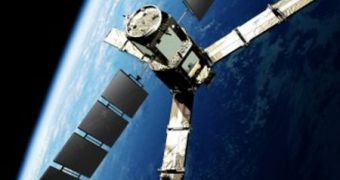After a long journey that lasted a few days, the Soil Moisture and Ocean Salinity (SMOS) satellite, an important part of the European Space Agency's (ESA) Living Planet Program, has been safely delivered to its launch site, the Plesetsk Cosmodrome, in northern Russia. The spacecraft was designed and built by southern France-based Thales Alenia Space and is scheduled to launch to orbit aboard a Rockot delivery system on November 2nd, AlphaGalileo informs.
The precious satellite, accompanied by seven containers of auxiliary equipment, left its assembly building on September 15th via a large Antonov aircraft. It arrived in Arkhangelsk, the Russian Federation, in the wee hours of the morning, on September 16th, and was then immediately placed on trucks and driven to its designated train station. After more than 12 hours spent in a special car, it finally reached its intended destination. The Plesetsk Cosmodrome is located about 800 kilometers north of Moscow and some 200 kilometers south of Arkhangelsk.
The observatory's main goal will be pretty straightforward and complex at the same time. It will have to provide its controllers with detailed knowledge of the planet's water cycle and climate. This will be accomplished by analyzing global soil moisture and ocean salinity, for which no thorough datasets exist at this time. As a secondary goal, the craft's measurements will also be used for more accurate predictions of crop yields in designated areas around the world.
SMOS will be launched to an orbital station about 763 kilometers above the surface, aboard a modified Russian Intercontinental Ballistic Missile (ICBM) SS-19. The Cosmodrome is in fact a decommissioned SS-19 launcher, which has now been converted into a rocket platform for orbital destination. The SMOS instrument will share its ride with another ESA satellite, the low-cost Proba-2, which is destined to observe the Sun with its two scientific instruments.
Proba-2's science equipment includes the Dual Segmented Langmuir Probe (DSLP), the Thermal Plasma Measurement Unit (TPMU), and the Science Grade Vectorized Magnetometer (SGVM). Its main instruments are the “Sun Watcher using Active Pixel System Detector and Image Processing” (SWAP) telescope and the “Lyman Alpha Radiometer,” or LYRA. The craft is a part of ESA's low-budget missions and weighs only 13 kilograms.

 14 DAY TRIAL //
14 DAY TRIAL //